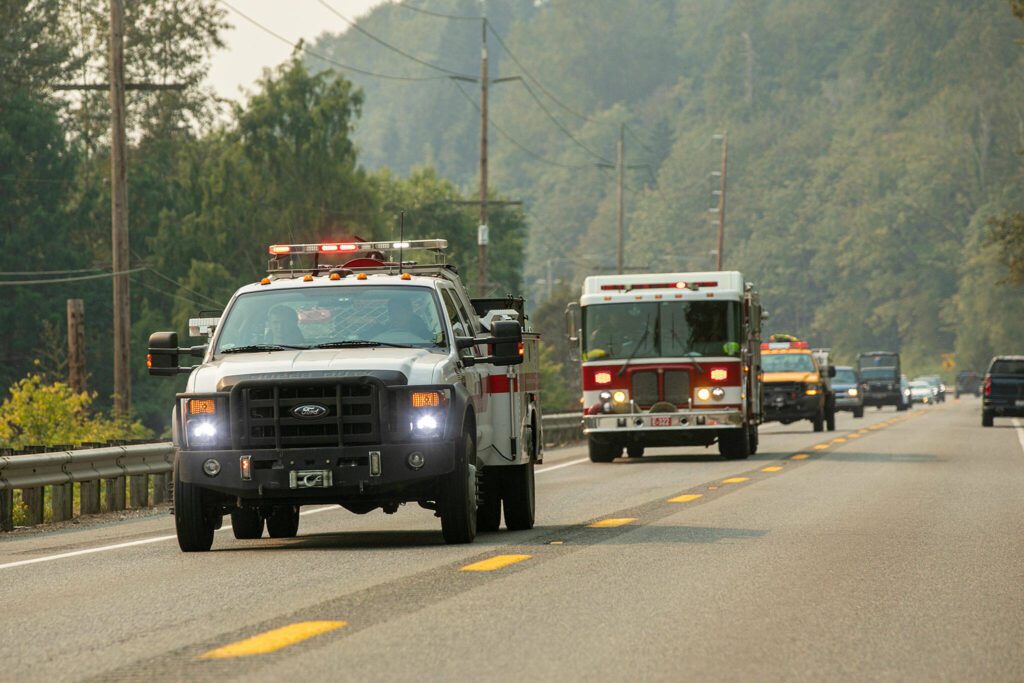EVERETT — Beginning this Thursday, the county’s emergency management team will share its first Community Wildfire Protection Plan, outlining how Snohomish County can be prepared for wildfire events at two in-person events.
The gatherings will focus on how to best protect community members and their properties in wildfire and evacuation situations for people living in or near wilderness boundaries.
The first meeting will be 5:30-7:30 p.m. Thursday in the Stillaguamish Conference Room of the city of Arlington Public Works Office at 238 N. Olympic Ave.
On May 22, the department will hold another public meeting 5:30-7:30 p.m. in the Startup Event Center at 14315 366th Ave. SE in Startup.
Almost 30 Washington counties already have protection plans, with a handful working on updates. The plan helps identify areas of risk, recommends forest health restoration projects, prioritizes areas for wildfire mitigation funding and encourages conversations about how communities can play a critical role in wildfire prevention.
An estimated 130,000 people, more than 15% of the county’s population, live in wildland-urban interfaces, areas where homes and businesses are surrounded by forested areas. In Snohomish County, communities like Gold Bar and Darrington are at high risk of being affected by wildfires.
At the meetings, the DEM will share the county’s first Community Wildfire Protection Plan — a product of the team’s past year of work meeting with state and federal agencies, local firefighters, nonprofits and tribes to holistically examine the county’s wildfire risks and needs.
“It’s just a back-and-forth conversation for us to educate the community about what they can be doing, and then for them to communicate back with us about where they might need additional assistance,” Emergency Management Director Lucia Schmit said in an interview on Monday.
As part of the protection plan, the team conducted a Community Wildfire Preparedness Survey in late summer 2024 to gather the county’s perceived wildfire risk, community and cultural values and perspectives about wildfire mitigation projects, such as forest thinning.
The survey summary indicated a strong interest in wildfire resiliency, meaning the preparation and implementation of wildfire risk planning, Schmit said. The department received over a thousand responses, and 59% of respondents said their concern about wildfires has increased over the past five years.
Another key insight from the survey was that 72% of respondents believe wildfire mitigation projects like forest thinning benefit forests. Seventy-four percent of respondents were “not at all familiar” or only “somewhat familiar” with home hardening strategies, such as opting for non-flammable roofing material or keeping vegetation-free buffers by driveways or roads for clear access.
The survey also showed that 34% of respondents don’t have an evacuation plan. With drier conditions and more people living in the wildland-urban interface, it’s important for people to be signed up for evacuation alerts and be prepared to leave their homes, Schmit said.
Western Washington is already far behind its precipitation averages, with a historically dry January. The Darrington station only recorded 26 inches of rain by the end of April, 30% lower than its average of 35 inches, according to the National Weather Service.
“We certainly have the start of the ingredients” for a bad fire season, said Dana Felton, a meteorologist at the National Weather Service.
People can sign up for evacuation alerts on the Snohomish Safety Hub website. While the county can push alerts to any geographical location regardless of whether you’re signed up, the benefit to signing up is that you can tie your cellphone to an address. That way, even if you’re not in the area but have a child or elderly parent at school or home, you’ll get up-to-date information on where they are.
Schmit also recommends having a to-go box ready with important documents, such as passports and insurance papers, a change of clothes and a favorite toy for children easily accessible in your house.
The Emergency Management Department will continue to develop its protection plan over the next two years, expanding on previous work done in the Skykomish and Stillaguamish valleys and gathering more insight from communities. As the department continues to learn what the county needs for wildfire and other extreme weather preparedness and resiliency, it’ll work to brainstorm how to meet those needs without certain federal funding.
Budget cuts won’t affect the team’s response readiness for this year’s fire season, Schmit said, as the department is still spending money from previous years’ grants. It might be a couple of years before they see an impact, Schmit said, but safety of lives will always be their top priority.
“It might take a little brainstorming to figure out how we can meet those gaps, but that’s what we’re there for,” she said.
For more wildfire preparedness information, you can visit https://www.snohomishcountywa.gov/3629/Wildfire-Preparedness.
Eliza Aronson: 425-339-3434; eliza.aronson@heraldnet.com; X: @ElizaAronson.
Eliza’s stories are supported by the Herald’s Environmental and Climate Reporting Fund.
Talk to us
> Give us your news tips.
> Send us a letter to the editor.
> More Herald contact information.






























